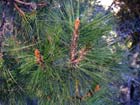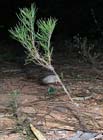
Tres along a rocky ridgetop [C.J. Earle, 2007.02.10].

Typical foliar units [C.J. Earle, 2007.02.10].

Typical foliar units at WP69 [C.J. Earle, 2007.02.10].

Seed with wing collected at campsite [C.J. Earle, 2007.02.11].

Bark on a 20 cm diameter tree [C.J. Earle, 2007.02.10].

Seedling about 15 cm tall [C.J. Earle, 2007.02.10].

Comparison of Pinus lumholtzii (left) and P. herrerae (right) cones [C.J. Earle, 2007.02.10].

Selection of cones, collected at campsite [C.J. Earle, 2007.02.11].

Pinus herrerae
Martínez 1940
Common names
Ocote, pino chino (Perry 1991).
Taxonomic notes
Syn: Pinus teocote var. herrerae (Martínez) Silba 1990 (Farjon and Styles 1997).
Description
Tree 25-35 m tall. Crown on young trees irregular, on mature trees rounded and open with horizontal to drooping branches. Bark thin, scaly, red-brown, with age becoming thicker, divided by longitudinal fissures into red-brown, scaly plates. Branchlets red-brown, smooth to slightly scaly with decurrent cataphylls. Leaves in fascicles of 3, 10-20 cm long, slender, flexible, mostly erect but occasionally somewhat drooping; margins finely serrate, stomata on all sides; resin canals 1-4, internal, occasionally with one septal or medial; outer walls of the endodermal cells thickened; fibrovascular bundles 2, contiguous but distinct; fascicle sheaths persistent, 8-14 mm long, pale brown. Seed cones long-ovoid, almost symmetrical, 2-4 cm long, reflexed on stout peduncles about 5 mm long; light brown, opening when mature, soon deciduous. Cone scales 5-6 mm wide, flexible, apophysis flat to slightly raised, lightly keeled; umbo slightly raised with a small, early-deciduous prickle. Seeds 3-4 mm long, dark brown, with an articulate wing 5-7 mm long. Wood pale yellow, of good quality (Perry 1991).
Distribution and Ecology
Mexico: Sinaloa, Durango, Jalisco, Michoacan, Guerrero; possibly in other areas. Grows at altitudes of 1,200-2,400 m, generally on moist, well-drained slopes where rainfall is 900-1,200 mm/yr. Associated pines include P. montezumae, P. pseudostrobus, P. douglasiana, P. maximinoi, P. lawsonii, P. teocote and P. devoniana (Perry 1991). "While this species is often found in mixed stands with other pines, I observed it growing in small, pure stands in southwestern Michoacan" (Perry 1991).
Zone 10 (cold hardiness limit between -1°C and +4.4°C) (Bannister and Neuner 2001).
Remarkable Specimens
Ethnobotany
Harvested for timber, usually in selective cutting, along with comparable timber species including P. pseudostrobus, P. devoniana, P. douglasiana and other pines. Locally cut for firewood and construction timber (Perry 1991).
Observations
Perry (1991) reports collecting it west of Durango and El Salto on Highway 40 near the village of Ciudad, as a roadside tree. I found it farther west on Highway 40, scattered along the highway for maybe 10-15 kilometers on both sides of the Durango/Sinaloa border.
(Perry 1991) recommends the best area, though, as in Michoacan:"From Mexico City drive west to the city of Uruapan; there take Highway 37 south to the village of Neuva ltalia and turn right onto Highway 120. Drive westward for about 25 km to the town of Apatzingan and find a guide who is familiar with the region south and west of Apatzingan. Drive on a dirt road to the village of Aguililla and continue about 20 km westward to the village of Dos Aguas, a small "sawmill village" in the heart of extensive pine forests. Around Dos Aguas are numerous logging trails into the forest and it will not be difficult to find specimens of P. herrerae on some of the trails."
Perry (1991) also reports finding P. herrerae in Jalisco near the village of Tuito, south of Puerta Vallarta. The trees there grow with P. strobiformis at 2,200 m altitude, one of the most disjunct occurrences of the species.
Remarks
P. herrerae is parasitized by the mistletoe Cladocolea cupulata Kuijt (Loranthaceae) (Kenaley and Mathiasen 2006) and the dwarf mistletoes Arceuthobium gillii, Arceuthobium rubrum, A. vaginatum subsp. vaginatum, and A. yecorense, described from its occurrence on this species near Yecora, Sonora (Hawksworth and Wiens 1996).
Citations
Martínez, M. 1940. Pinaceas Méxicanas: Descripción de algunas especies y variedades nuevas. Anales Inst. Biol. Univ. Nac. México 11(1):57-84.
See also
Dvorak, W.S., J.E. Kietzka, T.K. Stanger and M. Mapula. 2000. Pinus herrerae. Pp. 74-84 in Conservation & Testing of Tropical & Subtropical Forest Tree Species by the CAMCORE Cooperative. Raleigh, NC: College of Natural Resources, NCSU.








